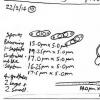
14-01-2026 10:02
Hulda Caroline HolteHello, These ascomycetes were growing on standing

13-01-2026 10:13
 Danny Newman
Danny Newman
Cordieritidaceae sp. on indet. wood w/ Hypoxylon s

13-01-2026 07:57
 Danny Newman
Danny Newman
cf. Bombardia on indet. decorticate woodAppalachia

14-01-2026 07:28
 Danny Newman
Danny Newman
Nemania sp. on indet. decorticate woodAppalachian

12-01-2026 22:02
Ethan CrensonHello all, I am hoping someone will have some ins

11-01-2026 20:35
Hello.A very tiny pyrenomycete sprouting sparsely

13-01-2026 18:55
Rees CronceStrossmayeria sp. on indet. decroticate hardwoodTh

13-01-2026 07:28
 Danny Newman
Danny Newman
Chlorociboria glauca on indet. decorticate logThe

13-01-2026 07:14
 Danny Newman
Danny Newman
Neodasyscypha cerina on indet decorticate logThe S

13-01-2026 09:10
 Danny Newman
Danny Newman
Dasyscyphella chrysotexta on indet. decorticate ha
Black Stromatic Asco Composed of Concave Discs
Peter Thompson,
25-02-2014 23:45
I have found a black stromatic ascomycete, the surface of which is formed from concave discs which are aligned at different angles to each other. The perithecia are embedded in the stroma.
The substrate is a twig of Salix. Also present on the other side of the twig is Chaetosphaerella phaeostroma.
An image of part of the fruit body is attached, along with a sketch of the microscopy.
I am not even sure about the genus, as it looks quite unusual.
Any assistance with identification would be appreciated.
Thank you,
With Best Wishes,
Peter.
Gernot Friebes,
25-02-2014 23:53
Re : Black Stromatic Asco Composed of Concave Discs
Hi Peter,
could be a Nitschkia.
Best wishes,
Gernot
could be a Nitschkia.
Best wishes,
Gernot
Peter Thompson,
26-02-2014 10:20
Re : Black Stromatic Asco Composed of Concave Discs
Hello Gernot,
Thank you for your reply.
I think that each disc is a maximum of 0.1mm in diameter. Under the discs, all fruit bodies are embedded or fused into a stroma - not able to be individually removed from the host.
In the Nitschkia key Mycologia 96(4), 2004, there is no mention of a species with fruit bodies embedded or fused into a stroma.
I think that my sample must be from another genus.
With Best Wishes,
Peter.
Thank you for your reply.
I think that each disc is a maximum of 0.1mm in diameter. Under the discs, all fruit bodies are embedded or fused into a stroma - not able to be individually removed from the host.
In the Nitschkia key Mycologia 96(4), 2004, there is no mention of a species with fruit bodies embedded or fused into a stroma.
I think that my sample must be from another genus.
With Best Wishes,
Peter.
DirkW,
26-02-2014 10:41

Re : Black Stromatic Asco Composed of Concave Discs
hi peter, perhaps melanopsamma could be a further idea. the fruitbodies also collapse and spore-shape fits better than nitschkia ...
best
dirk
best
dirk
Peter Thompson,
28-02-2014 10:59
Re : Black Stromatic Asco Composed of Concave Discs
Hello Dirk,
Thank you for your reply.
I have had a look into Melanopsamma and think that I still have the problem with my fruit bodies being embedded in a cushion like stroma, rather than growing individually on the surface of the host.
The spores and collapsing characteristic certainly look correct.
With Best Wishes,
Peter.
Thank you for your reply.
I have had a look into Melanopsamma and think that I still have the problem with my fruit bodies being embedded in a cushion like stroma, rather than growing individually on the surface of the host.
The spores and collapsing characteristic certainly look correct.
With Best Wishes,
Peter.
DirkW,
28-02-2014 11:45

Re : Black Stromatic Asco Composed of Concave Discs
hello peter, the picture is very dark. is it really a hard stroma or a hairy subiculum?
best
dirk
best
dirk
Thomas Læssøe,
28-02-2014 12:58
Re : Black Stromatic Asco Composed of Concave Discs
there is also a parasitic Nitschkia. The stroma could be the host
Jaklitsch Walter,
28-02-2014 14:31
Re : Black Stromatic Asco Composed of Concave Discs
although there is not that much to see, I would think that this is Pachythyrium parasiticum on a (?)Diatrype sp.
The upper peridium is usually more or less radially striate and the asci should be bitunicate.
Best regards, Walter
The upper peridium is usually more or less radially striate and the asci should be bitunicate.
Best regards, Walter
Peter Thompson,
28-02-2014 20:55
Re : Black Stromatic Asco Composed of Concave Discs
Hello Walter, Thomas and Dirk,
Thank you all for your comments and guidance.
I have had another look under the microscope and see that the fruit bodies indeed have walls of radiating of dark cells. I am satisfied that the fruit bodies are thyriothecia, crowded together and that the spheres containing the asci and spores are contained in a thin layer just beneath the surface.
As there are the remains of a Eutypa sp. in close proximity, I think that it is very likely that some Eutypa fruit bodies have been overgrown.
I also note that below the blackish brown cells, there are reddish gold cells (seen in a water mount).
I believe, from the species description of Pachythyrium parasiticum, that the characteristics match, and that Walter has correctly identified the fungus.
With Best Wishes,
Peter.
Thank you all for your comments and guidance.
I have had another look under the microscope and see that the fruit bodies indeed have walls of radiating of dark cells. I am satisfied that the fruit bodies are thyriothecia, crowded together and that the spheres containing the asci and spores are contained in a thin layer just beneath the surface.
As there are the remains of a Eutypa sp. in close proximity, I think that it is very likely that some Eutypa fruit bodies have been overgrown.
I also note that below the blackish brown cells, there are reddish gold cells (seen in a water mount).
I believe, from the species description of Pachythyrium parasiticum, that the characteristics match, and that Walter has correctly identified the fungus.
With Best Wishes,
Peter.

